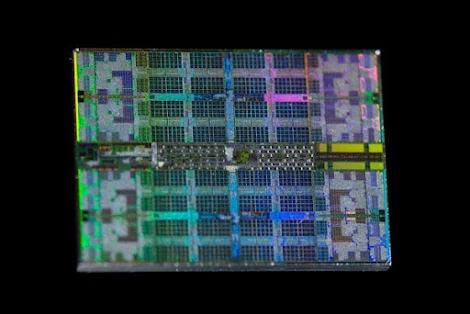Exploring the Limits of the AMD ThreadRipper CPU: Physics and Practicality
The AMD ThreadRipper CPU is a marvel of modern technology, pushing the boundaries of what we can achieve with computational power. This blog post delves into the physical constraints and ingenious design choices that make this processor both powerful and efficient.
The Size and Speed of the AMD ThreadRipper CPU
The AMD ThreadRipper CPU is a substantial piece of hardware, measuring 58.5 mm × 75.4 mm. If we imagine a photon traveling from one corner of the processor to the opposite corner, it would have to cover a distance of 133.9 mm. Given the speed of light, a photon can make this journey 2,240,477,968 times per second, equating to a frequency of 2.24GHz.
Theoretical Limits of Light Speed and Processor Sync
In an ideal world, using a perfect medium (a vacuum) and light as a transmitter, the maximum achievable synchronization frequency for the entire surface area of the processor would be 2.24GHz. However, in real-world applications, we use silicon as the medium and electrons for transmission. This means the actual synchronization limit is even lower due to the slower speed of electrons compared to photons.
Understanding the 4GHz Rating: Beyond Simple Physics
Despite these theoretical limits, the AMD ThreadRipper is rated to operate up to 4GHz. Does this mean we are somehow violating the laws of physics? The answer is no. The explanation lies in the architecture and design of the CPU.
Multicore and Multi-Processor Design
The ThreadRipper is not a single monolithic processor. Instead, it is composed of four processors combined into a single package. Each of these processors contains multiple independent units, known as cores, and a sophisticated communication system, often referred to as a fabric, which handles data exchange between these processors.
By dividing the computational task into smaller, more manageable segments, each processor can work on a separate problem in parallel. This parallel processing approach allows the CPU to handle complex tasks efficiently without exceeding the physical limits of speed and synchronization.
Why CPUs Won’t Exceed 4–5GHz
Physical and Practical Constraints
The primary reason general-purpose CPUs are unlikely to exceed speeds of 4–5GHz lies in the practical limitations imposed by physics. Higher frequencies would necessitate reducing the functional area of the processor to extremely small dimensions. This would make it impractical to perform large-scale computations on a single processor.
Heat Dissipation and Power Consumption
Higher operating frequencies also lead to increased heat generation and power consumption. These factors contribute to diminishing returns on performance improvements at higher clock speeds. Efficient heat dissipation becomes challenging, and the additional power requirements can outweigh the benefits of marginal speed increases.
Optimized Task Division
Modern CPU designs, like the ThreadRipper, optimize performance by leveraging parallelism and task division. Instead of relying on a single core to perform all computations, multiple cores work concurrently on different segments of a task. This approach maximizes the use of available computational resources without pushing the clock speed beyond practical limits.
The Future of CPU Development
As we look to the future, the emphasis will likely remain on increasing the number of cores and improving parallel processing capabilities rather than merely increasing clock speeds. Innovations in materials science, chip architecture, and cooling technologies will play a significant role in advancing CPU performance.
Beyond Silicon: New Materials
Exploration of new materials beyond silicon could lead to breakthroughs in processor speed and efficiency. Graphene and carbon nanotubes are among the promising candidates that could offer superior electrical properties and thermal management.
Quantum Computing
Another frontier is quantum computing, which holds the potential to revolutionize computational power by leveraging the principles of quantum mechanics. While still in its nascent stages, quantum computing could eventually complement traditional CPUs, tackling problems that are currently beyond our reach.
Conclusion
The AMD ThreadRipper CPU exemplifies how innovative design and parallel processing can overcome the physical limitations of traditional computing. While the laws of physics impose certain constraints, advances in technology continue to push the boundaries of what is possible. Understanding these principles not only helps us appreciate current technology but also inspires the next generation of breakthroughs in computational power.






.jpg)









0 Comments